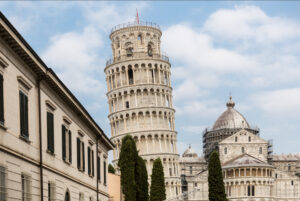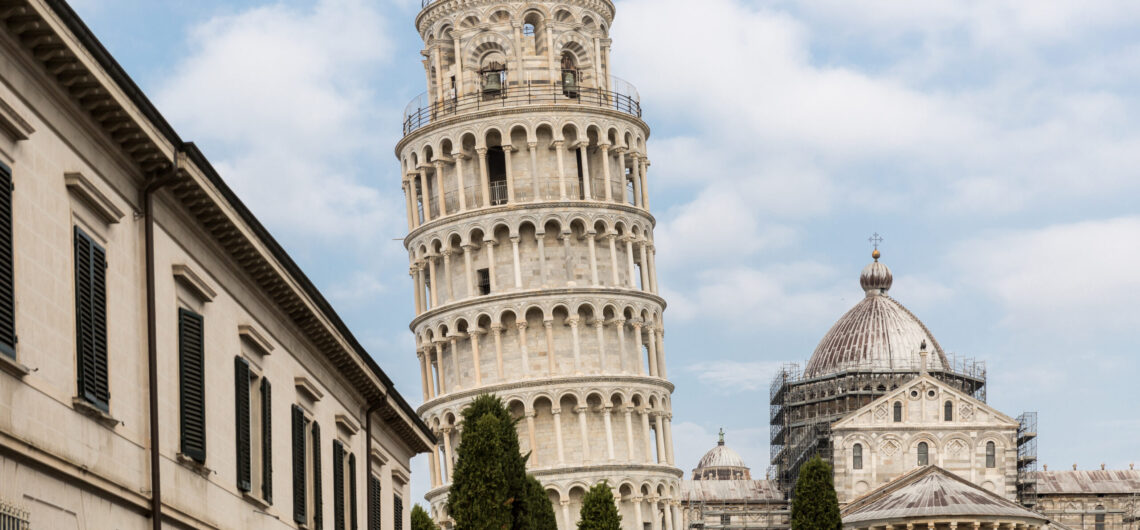Marvel of Architecture and History of Leaning Tower Pisa
The Leaning Tower of Pisa, or “Torre Pendente di Pisa”, is one of the most iconic landmarks in the world. Located in Pisa, Italy, this freestanding bell tower has captivated visitors with its unique tilt and remarkable history. It stands as a testament to human engineering, resilience, and a touch of luck.

History Behind the Leaning Tower
Construction of the Leaning Tower began in 1173, and it was originally intended to be a straight tower, designed to complement the grand cathedral and baptistery in the Piazza del Duomo. The tower was planned to be a monument to Pisa’s wealth and power during the medieval period, with the goal of showcasing the city’s prosperity.
However, problems started early in the construction process. By the time the third floor was completed, the tower began to lean to the southeast due to an unstable foundation. This unexpected tilt was caused by the soft, marshy soil that could not support the massive weight of the structure. Despite the tilt, construction continued intermittently over the centuries, with efforts to correct the lean and ensure the tower’s stability. The final height of the Leaning Tower is 57 meters (186 feet), and it has 8 stories, including the chamber for the seven bells.
Architectural Design and Structure
The Leaning Tower of Pisa is made of white and grey marble and stands at an elegant 57 meters tall. Its design is Romanesque, featuring a cylindrical structure with eight stories, including the base. The tower’s most notable feature, of course, is its tilt. The tilt is currently about 3.97 degrees, though it has fluctuated over the years.
Each story is adorned with arches and columns, and the tower’s spiral staircase has 294 steps. The most prominent part of the tower is the bell chamber at the top, which houses seven bells, one for each note of the musical scale. The tower’s construction was a long and complex process, involving several architects over nearly 200 years. The names of the key architects associated with the tower’s design include Bonanno Pisano and Giovanni di Simone.
The Leaning Tower of Pisa’s tilt became a major concern during the 20th century. By the 1990s, the tilt had reached a dangerous angle, making the tower unstable and at risk of collapsing. In 1990, authorities were forced to close the tower to the public and initiate a series of restoration projects to prevent disaster. Engineers and experts from around the world were brought in to assess the situation.
Using a combination of methods, including soil stabilization, the addition of counterweights, and the removal of some of the tower’s weight, the tilt was reduced to a safer angle. The restoration work lasted for over a decade, and in 2001, the Leaning Tower of Pisa was officially reopened to the public.
Today, the tilt is much less pronounced, and the tower is safe for visitors to climb once again.

A Symbol of Pisa and Italy
The Leaning Tower of Pisa is more than just a remarkable architectural, it is also a symbol of Italy’s rich cultural and historical heritage. It attracts millions of visitors each year, who come to marvel at its beauty, snap photos with the iconic tilt, and learn about its fascinating history.
In addition to being a tourist attraction, the Leaning Tower of Pisa is also part of the UNESCO World Heritage Site known as the “Piazza del Duomo” (Cathedral Square). This square is home to not only the tower but also the Pisa Cathedral and Baptistery, which are also architectural masterpieces in their own right.
The tower’s peculiar lean has inspired countless stories and legends. It also represents the spirit of resilience. Despite its challenges and the structural issues it faced, the Leaning Tower of Pisa continues to stand proudly, a symbol of engineering ingenuity and Italian heritage.
The Leaning Tower of Pisa is undoubtedly one of the world’s most famous monuments, known for its unmistakable tilt, architectural beauty, and the challenges it has faced throughout its history. It is a symbol of both the power and imperfection of human endeavor, showing how even a mistake can lead to something magnificent.
Whether you are an architecture enthusiast, a history, or simply a traveler looking for an unforgettable experience. Join our favorite tour from VIP Tour Europe, the Leaning Tower of Pisa remains a must see destination that continues to inspire and fascination. VIP tour Europe always ready for your private tour with your loved ones.

